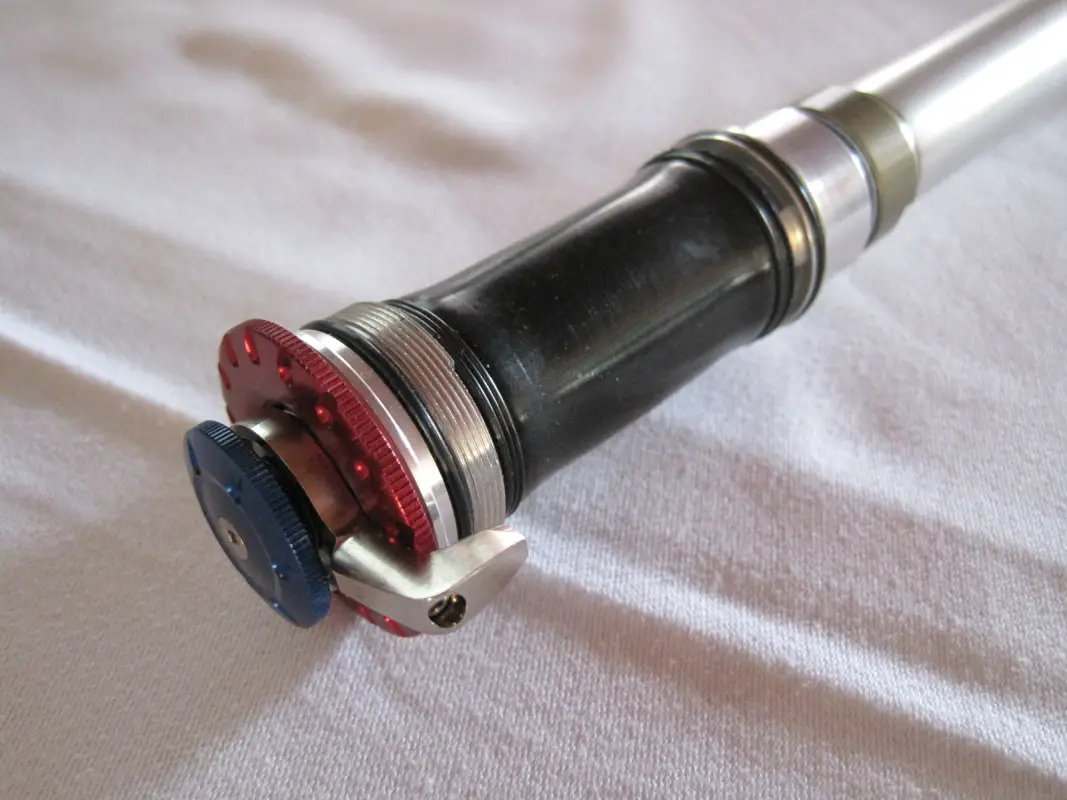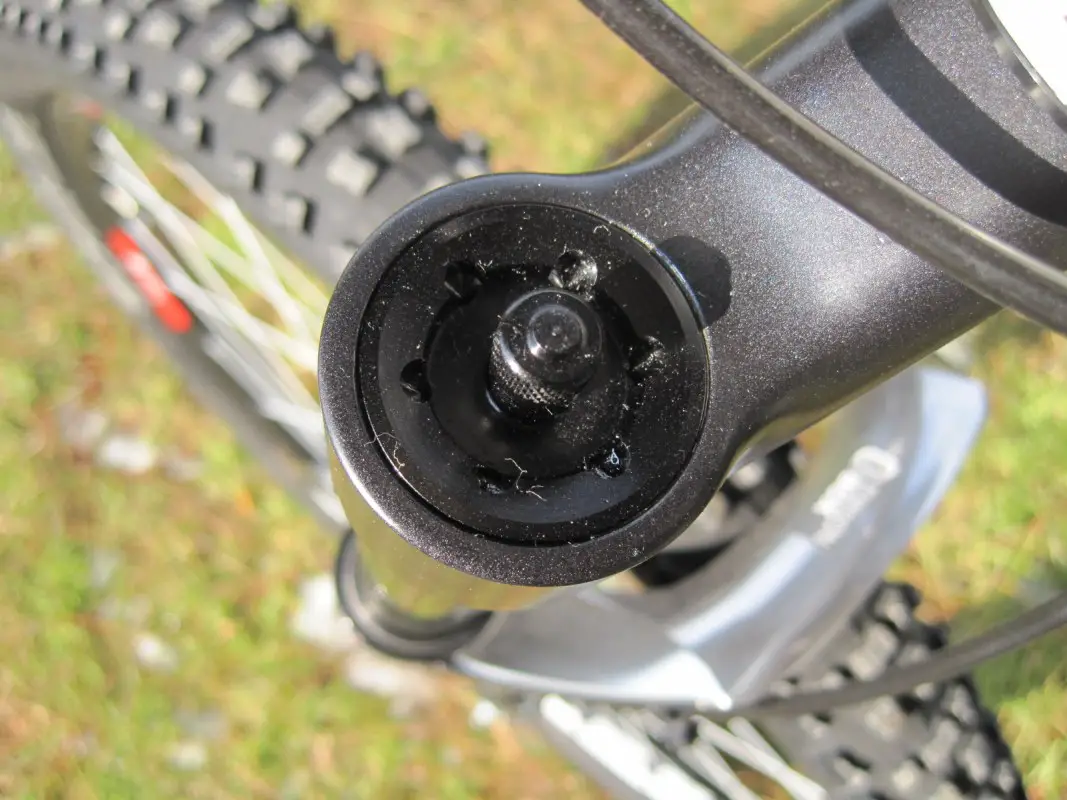DT Swiss purchased the suspension fork design from Pace a couple of years ago now. And since then the forks have basically been the same product but with different decals and stuff. For 2010 the forks bearing DT Swiss’ name are now vastly different internally to the previous Pace forks. The external adjustment dials are also different (more of this later).
The fork crown and the fork lowers are still very much the Pace design. The main reason DT Swiss purchased the fork designs was because they very much admired the lowers of Pace forks – and the patented “hollow arch” brace. DT Swiss claim that the design of the fork lowers means their forks have the best stiffness-to-weight rating on the market. They’ve tested everyone else’s forks on a fancy machine. Some forks (Magura Menja for example) are torsionally stiffer but they’re significantly heavier. Stiffness combined with weight is what DT Swiss are interested in. Their testing is done with a wheel in the fork by the way (some people assume that it isn’t).

As well as the familiar carbon fibre versions, DT Swiss are making (significantly cheaper) versions of most of their forks using magnesium lowers. The forks use either 9mm or 15mm RWS axle types.

The new “guts” design has the pump piston integrated into the stanchions (see pic below). One claimed benefit of this is better heat dissipation through the stanchions. It also enables an extremely light weight fork; the XRC 100 weighs 1150g (2.53 lbs). Blimey.
The new DT Swiss forks are split into two different damping designs: “Twin Shot” and “Launch Control II“.

Let’s deal with the Twin Shot forks first.
Twin Shot damping is found on the shorter travel, trail riding forks (XRC, XC, XMM and XMC forks). Christian at DT Swiss explained Twin Shot as being like “BMW Sports Mode”. Firm and racey damping. It was designed with a lot of input from XC/Marathon racers on the Scott Racing team and fast folks like Thomas Frischknecht. All the adjustments are positioned on top of the fork legs so everything tweaky is within reach whilst riding.
Adjustments available: rebound, low speed compression, fork lock-out, fork lock-down (the fork sits approx 1/3 compressed in lock-down setting). There are dedicated circuits for high speed compression and high speed rebound but these are factory preset and non-adjustable.



A piston pushes oil into a rubber bladder-sealed chamber at the top of the fork. Oil does not pass through the piston head. Lubrication oil and damping oil are two separate entities that do not mix. A relatively small volume of oil is required for the Twin Shot system. All air in the system is under pressure (the pressure in the rubber bladder is factory-set to 5 bar) so it does not mix with any oil and cause foamy “cavitation” problems.

On to the Launch Control II damped forks now. This system is found on the EXC and EXM forks. Christian described this damping system as “Mercedes Touring mode”. A bit more active and much more linear in feel. Cushy. It’s a combination of an open bath and a cartridge design.
You may be familiar with the “lock-down with automatic blow-off release” Launch Control idea from when Pace had it on their RC40 series forks. The essential design is pretty much the same but the execution has been tweaked a lot. The rebound and threshold adjustment range is broader on the new DT Swiss forks. And the dials are all indexed, very positive and clicky. So no more accidental adjustment of the rebound lever by brushing through the undergrowth or from overly flappy baggy shorts.

Some of the Twin Shot and the Launch Control II forks have DT Swiss’ other new thang: ABS. This stands for Auto Balancing Spring system. This is “self setting positive and negative air chambers” – one Schraeder valve (on top of the fork leg) does both. When the fork is in its fully extended position an inter-chamber valve is fully open, so the pressure is the same in both positive and negative chambers. This valve closes as soon as the fork begins to compress (when the fork compresses about 2mm to be exact) and from this point (as the fork compresses) the negative pressure drops and the positive pressure increases. It should make for a very linear feel.












captivation? not cavitation?
I do like the rear arch design – akin to the Manitou’s of old (whatever happened to them?)
However: Please please who in the UK is selling those White Rocket Ron’s, that is without paying for a top of the line Scott?
Oops. Cavitation yes. Will edit now.
White Rocket Rons will be available for the general public to buy in the next month or two iirc.
no 20mm axle options = i’m not going to bother
Oh I assumed they did 20mm… that’s a bit sad.
I was also getting slightly excited but don’t think I’ll bother ether.
Hmmm, now then, shall we guess the price of the XMM 140? £900 I reckon.
Thanks Benji, i’m grabbing them before they change any minds.
Auto Balancing Spring system.
The dampers sound interesting, ABS just sounds like RS Solo Air in forks, or the Fox negative spring in their air rear shocks.
“about 2mm to be exact” interesting combination of words 🙂
Are the Pace guys still involved in any of this at all, or have DT completely taken over now? I seem to remember something being said originally about them remaining in a consultancy role… That said, those DT internals destinctly lack the charismatically Heath Robinson approach of original Pace forks, so I’m guessing maybe Adrian and Co. have been paid off somewhere along the way..?
Pace have no involvement at all anymore.
They’re busy designing frames now (more of which later this week…. ;-))
Pricing can be found on madison.co.uk
http://www.madison.co.uk/searchresults.aspx?style=0&kw=sfdt
I know this is going to be a stupid question (as never before in the history of a bike upgrade has it been true), but is there any hope that they liked the old externals so much that they are COMPLETELY unchanged and therefore the new internals will be useable in my old forks?
to be honest, I reckon you could probably get away with popping those internals inside a pair of 2001 Proclass 2s, no worries! An instant upgrade to modern technology, without any of the hassle 😉
I think Pace invented the rear arch – and Manitou knicked it.
Please bin the rear arch – I know the science makes sense, it just makes for gopping forks – it’s at least 50% of the reason Manitou don’t sell any non OEM forks (Doritos excepted)